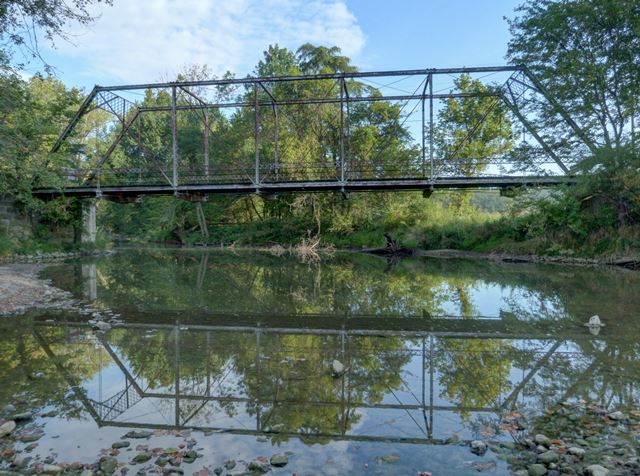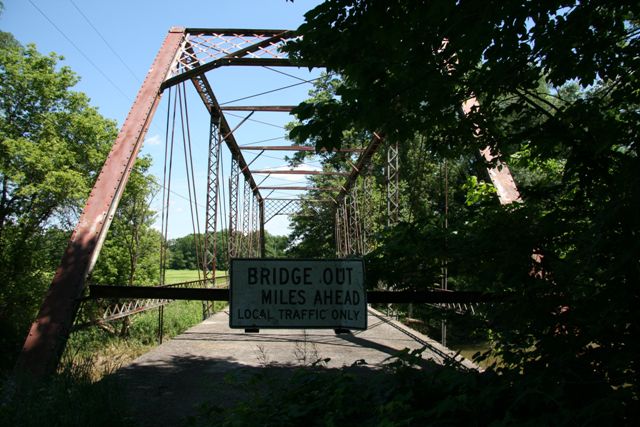We Recommend:
Bach Steel - Experts at historic truss bridge restoration.
Caldwell Road Bridge

Primary Photographer(s): Nathan Holth and Rick McOmber
Bridge Documented: June 20, 2010 and September 11, 2015
Rural: Crawford County, Ohio: United States
1890 By Builder/Contractor: Variety Iron Works of Cleveland, Ohio
Not Available or Not Applicable
113.0 Feet (34.4 Meters)
114.2 Feet (34.8 Meters)
15.7 Feet (4.79 Meters)
1 Main Span(s)
1738208

View Information About HSR Ratings
Bridge Documentation
View Archived National Bridge Inventory Report - Has Additional Details and Evaluation

This bridge is one of less than a handful of known surviving example of bridges built by the Variety Ironworks of Cleveland, Ohio remaining in the country, and the only one in the company's home state of Ohio. Some of the details on the Caldwell Road Bridge that are seen on some of the other surviving examples include the use of lattice instead of cover plate for some of the top chord, the pedimented struts, and the design of lattice portal bracing.
This bridge is abandoned, but it retains excellent historic integrity. Because of the rarity of the bridge builder and the unusual design details this bridge should be given an extremely high preservation priority. As the suggested Historic Bridge Inventory Management Plan for the bridge says, a great solution would be to relocate and preserve this bridge for pedestrian use in a new location.
Information and Findings From Ohio's Historic Bridge InventorySetting/Context The bridge carries a 1 lane road (closed to traffic) over a stream in a sparsely developed, rural setting. Physical Description The 1 span, 114'-long, pin-connected Pratt thru truss bridge is supported on stone abutments. The lightly built bridge has eyebar lower chords and diagonals. The lower chords are guided through the floorbeam hangers in the end panels by a casting with clamps. The upper chords are toe-out channels with lacing on top and battens below. The verticals are channels with lacing. The bridge has A-frame lattice portals. The upper lateral bracing is a shallow, built-up variable depth beam with brackets. It has built-up shaped beams supported from hangers at the lower chord panel points. It is finished with lattice railings. Integrity Closed in 1988 due to a crushed floorbeam. The bridge has integrity of design, but materials are deteriorating. Summary of Significance The pin-connected Pratt thru truss bridge was
reportedly built in 1890 by the Variety Iron Works of Cleveland,
according to ODOT's first bridge inventory, although the builders plaque
has been lost and the county does not have written documentation. The
bridge is technologically significant because of its date of
construction and non-standard details, including upper lateral bracing,
portal bracing, upper chords, shaped beams, and lower-chord clamps at
the floorbeam hangers (Criterion C). This is the only documented example
of a bridge built by the Variety Iron Works in the ODOT inventory (July
2009). The Variety Iron Works was established prior to 1879 when a fire
destroyed the works. The works were rebuilt and by 1894 it reported a
3,500 ton annual capacity, which had expanded to 10,000 tons by 1903,
making it among the six largest bridge works in Ohio. As the company
names suggests, however, it did a "variety" of iron and steel
fabrication and erection, including buildings, but it was perhaps best
known for its dock machinery, including the famous Hulett iron-ore
unloaders. Justification Although within well represented population, this example is a rare example of a state fabricator and it is complete. Bridge Considered Historic By Survey: Yes View PDF Historic Bridge Inventory Sheet and Historic Bridge Management Plan |
This bridge is tagged with the following special condition(s): Unorganized Photos
![]()
Photo Galleries and Videos: Caldwell Road Bridge
2010 Bridge Photo-Documentation
Original / Full Size PhotosA collection of overview and detail photos. This gallery offers photos in the highest available resolution and file size in a touch-friendly popup viewer.
Alternatively, Browse Without Using Viewer
![]()
2010 Bridge Photo-Documentation
Mobile Optimized PhotosA collection of overview and detail photos. This gallery features data-friendly, fast-loading photos in a touch-friendly popup viewer.
Alternatively, Browse Without Using Viewer
![]()
2015 Additional Unorganized Photos
Original / Full Size PhotosA supplemental collection of photos that are from additional visit(s) to the bridge and have not been organized or captioned. This gallery offers photos in the highest available resolution and file size in a touch-friendly popup viewer.
Alternatively, Browse Without Using Viewer
![]()
2015 Additional Unorganized Photos
Mobile Optimized PhotosA supplemental collection of photos that are from additional visit(s) to the bridge and have not been organized or captioned. This gallery features data-friendly, fast-loading photos in a touch-friendly popup viewer.
Alternatively, Browse Without Using Viewer
![]()
Maps and Links: Caldwell Road Bridge
Coordinates (Latitude, Longitude):
Search For Additional Bridge Listings:
Bridgehunter.com: View listed bridges within 0.5 miles (0.8 kilometers) of this bridge.
Bridgehunter.com: View listed bridges within 10 miles (16 kilometers) of this bridge.
Additional Maps:
Google Streetview (If Available)
GeoHack (Additional Links and Coordinates)
Apple Maps (Via DuckDuckGo Search)
Apple Maps (Apple devices only)
Android: Open Location In Your Map or GPS App
Flickr Gallery (Find Nearby Photos)
Wikimedia Commons (Find Nearby Photos)
Directions Via Sygic For Android
Directions Via Sygic For iOS and Android Dolphin Browser
USGS National Map (United States Only)
Historical USGS Topo Maps (United States Only)
Historic Aerials (United States Only)
CalTopo Maps (United States Only)


